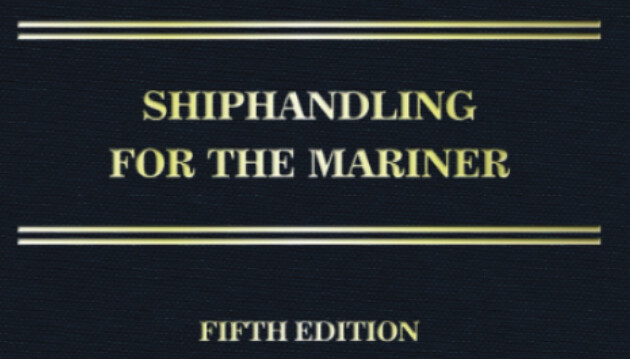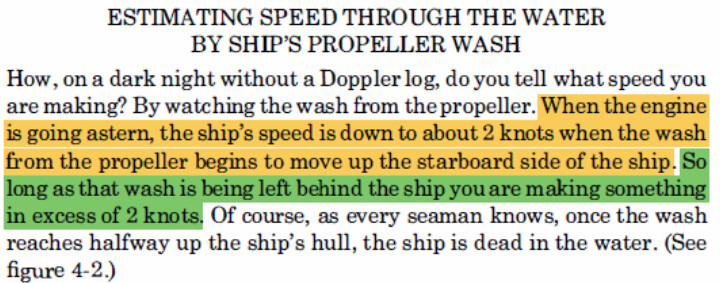Question came up on another thread, where on the bridge should the conning officer be when anchoring?
Where precision is required, for example an anchorage with assigned anchor positions, in my experience it’s best to be in the wheelhouse with good access to the ECIDS or radar, Doppler etc.
From inside the wheelhouse with the position (GPS Lat / Long) entered into the radar the precise bearing and range to anchor position and ship’s GPs course / speed vector is available. It’s also possible to watch Doppler fore / aft / athwartships SOG.
Stepping out onto the wing can give a sense of the situation but having done it both ways (from inside the wheelhouse and on the wing) the advantages from being inside outweigh the benefits of being out on the wing. Of course direct visual information is used to verify / crosscheck
2 Likes
There was a difference between how some ships were actually being anchored and the description in the book (Shiphandling for the Mariner MacElrevey 4th ed)
This is from page 164 in the chapter on Anchoring"
It’s not the case that the task is as described and it’s not correct that there’s only one way to anchor. There are other ways besides putting the ship on the final heading with the wind ahead.
Keeping the bow of a carship into a strong gusty wind can take a heavy hand on the bowthruster, in some situations it’s often easier and quicker to anchor downwind than fighting the wind. Why not use the anchor to assist?
MacElrevey advised to put up a fight:
When I was mate on anchor watch I observed some ships (bulkers in ballast for example) drift in to the anchorage with the wind abeam and anchor.
A few pages later an updated edition of MacElrevey added this:
I anchored car ships this way few times.
Discussed on this thread Anchoring Downwind and Variations
2 Likes
Who asked that question and in what thread ? should not remain a mystery .
Glad to observe we are preaching to same authority on the issue and drink from the same chalice of nautical wisdom .
Surprising though is , some express an indignation at ways the nintendo generation @Meme.Lord , @Gruntledemployee & others do not follow the ancient, well established and tested ways regarding traditional navigation methods in other threads like " Children of the magenta line and similar. .
Yet same critics in another thread seem to be enamored and highly dependent on electronic aids to navigation as depicted above. The amplitude of views and opinions looks quite large here.
Getting to anchor position with high end precision is one thing and can not be done from the bridge wing and/or monkey deck unless with handheld gps or ppu or tablet/laptop.
Letting go anchor in conditions described in other thread can.
Not all ships are equipped with working doppler and/or stw traditional log in perfect condition. Relying solely on gps while spoofing , jamming is now a buzzword among the scare mongerers seems to me a little odd to say the least.
1 Like
This is the key:
It’s not and either-or situation wrt instruments / visual.
The Aleutian Freighter where I sailed as mate lacked tools such as GPS, Doppler and didn’t have a reliable compass for a few trips. Once the skills required to navigate (including anchoring) in those conditions are acquired they don’t go away when working in a better equipped wheelhouse.
I agree that Shiphandling for Mariners is a valuable resource but I think the advice to use ranges and so forth to anchor applies more to pilots who typicality are going to use familiar anchorages.
Here is a good illustration (from the older thread linked here). It shows anchoring downwind and it can also be used to show anchoring with the wind on the beam.
Figure 4 – Example of Orthogonal Anchoring. (Illustration courtesy of D. Barber)
This method uses environmental forces (wind and current) rather than fighting them. One disadvantage is properly controlling the rate the chain is paid out requires more skill and good judgement from the crew on the bow.
3 Likes
First time I tried anchoring other then into the wind I drifted with about 15 kts of wind on the beam and lowered the anchor just underfoot. Then as the ship swung into the wind we paid out another half shot (shackle) or so.
Once the ship was headed into the wind it required a kick astern with the engine to lay out the chain.
Later I started anchoring with higher wind speeds on the beam using the bowthruster to slow swing of the bow. From there it’s an obvious step to approach the anchor position from upwind.
The 180 degree turn from downwind will rapidly knock off ship’s momentum so the ship’s speed during the initial approach to the anchor position can be significantly higher than the standard head-into-the-wind approach but after the anchor is let go lower speeds have less risk in the event the crew on the bow doesn’t pay out the chain at the rate required to match ship’s SOG.








